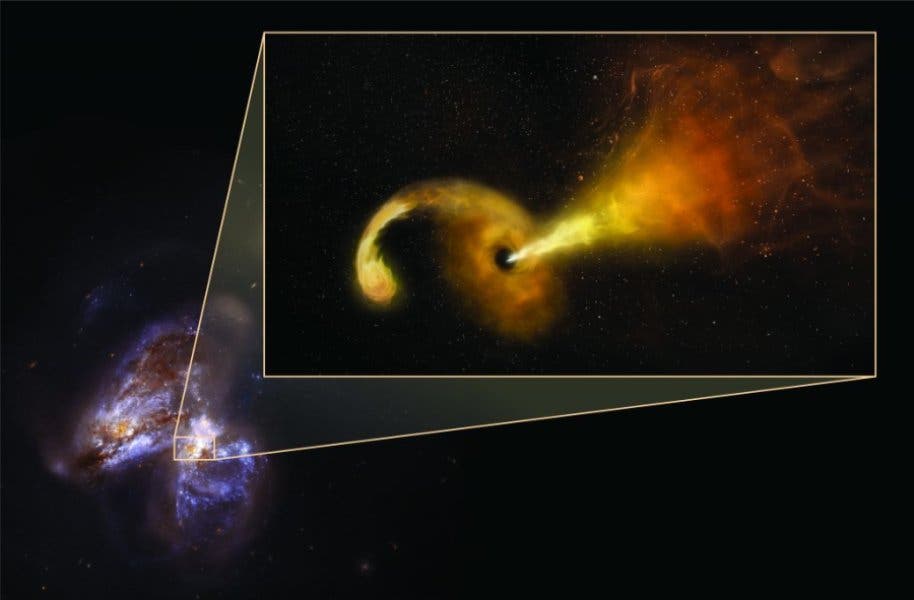Nearly 150 million light-years away from Earth, two distant galaxies are colliding in a tragic dance that will ignite billions of suns like fireworks. At the heart of one of these galaxies, however, there’s another violent event playing out. For the first time, astronomers have directly imaged a supermassive black hole ejecting a fast-moving jet of particles as it shreds a passing star.

Artist impression of Tidal Disruption Event (TDE) in Arp 299. The background image is a Hubble Space Telescope image of Arp 299, a pair of colliding galaxies. Credit: Sophia Dagnello, NRAO/AUI/NSF; NASA, STScI.
Supermassive black holes aren’t your ordinary stellar-variety black holes whose mass is just a couple of times that of our sun. Instead, these objects can have millions or, in some extreme cases, billions of solar masses. Virtually every galaxy has a supermassive black hole lurking at its center, which directly influences its development. Our own galaxy, the Milky Way, is no exception.
A supermassive black hole’s huge gravitational pull will actively draw material from its surroundings, but not all of it will be gobbled in at once. Instead, the black hole will form a rotating disc around it and launch superfast jets of particles from the poles of the disk at nearly the speed of light.
In 2005, astronomers working with the William Herschel Telescope in the Canary Islands identified a bright burst of infrared emission coming from the nucleus of one of the colliding galaxies in Arp 299. A bit later, the National Science Foundation’s Very Long Baseline Array (VLBA) revealed a new, distinct source of radio emission from the same location.
“As time passed, the new object stayed bright at infrared and radio wavelengths, but not in visible light and X-rays,” said Seppo Mattila, of the University of Turku in Finland in a statement. “The most likely explanation is that thick interstellar gas and dust near the galaxy’s center absorbed the X-rays and visible light, then re-radiated it as infrared,” he added.
Continued observations with the VLBA and other radio telescopes confirmed the presence of a source of radio emissions expanding in one direction, typical of a jet, just like scientists expected.
The Very Long Baseline Array (VLBA) is a massive interferometer consisting of 10 identical antennas on transcontinental baselines spanning up to 8,000 km, from Mauna Kea, Hawaii to St. Croix, Virgin Islands. These multiple radio antennas separated by thousands of kilometers allow the VLBA to gain an incredible resolving power — the ability to see fine detail — which is required to observe the features of an expanding object from millions of light-years away. The VLBA observes at wavelengths of 28 cm to 3 mm (1.2 GHz to 96 GHz) in eight discrete bands plus two narrow sub-gigahertz bands, including the primary spectral lines that produce high-brightness maser emission.
According to the researchers, the jet is emitted by a supermassive black hole, located at the heart of one of the colliding galaxies pairs called Arp 299. The black hole is about 20 million times more massive than the Sun and is currently shredding a star over two times as massive as the Sun, that was unfortunate enough to drift too close to the gargantuan monster. The superfast jet of charged particles emitted by the black hole packs a staggering 125 billion times the amount of energy the sun releases per year.
Only a small number of such stellar deaths called tidal disruption events, or TDEs, have been detected. The bursts propagate all over the electromagnetic spectrum, from radio, visible, and UV all the way to X-ray and gamma-ray intervals.
“Never before have we been able to directly observe the formation and evolution of a jet from one of these events,” said Miguel Perez-Torres, of the Astrophysical Institute of Andalusia in Granada, Spain.
Because the dust around the black hole absorbed any visible light, this particular TDE might be indicative of a hidden population of similar events — the tip of the iceberg, if you will. Mattila and Perez-Torres hope to discover many more such events and learn from them by directed infrared and radio telescopes to candidate sources.
TDEs are important to astronomy since they provide unique insight into the formation and evolution of jets in the vicinity of massive objects. Such events are likely common in the distant universe and studying them will advance our understanding of galaxies that developed billions of years ago.









